Lecture 7 - Knowledge Categories and Concepts
1/61
There's no tags or description
Looks like no tags are added yet.
Name | Mastery | Learn | Test | Matching | Spaced |
|---|
No study sessions yet.
62 Terms
Explain an example of how our knowledge is organised?
Let’s say someone gives you this prompt, “When Lisa was on her way back from the store with the balloon, she fell and the balloon floated away.” Then if someone asks you the following questions:
How old is Lisa?
5 years old
What does the balloon look like?
red
What’s inside the balloon?
helium
This information was not given in the text, but can be inferred because our knowledge is highly structured. For instance, we can infer that Lisa is young because kids usually hold balloons and are more susceptible to tripping. Also, balloons we see are usually red and helium is usually inside. Therefore, the information that we gathered from the prompt fits the schema we have.
How is semantic memory organised?
Our semantic memory is organised into categories.
Define a category.
A group of objects that belong together and have something in common.
Define exemplar.
One item within a category.
Define a concept.
Mental representation of the category.
How do categories help us when it comes to predicting how things will go in new situations?
Categories allow us to predict what will likely happen in new situations because they treat all exemplars as similar. Therefore, allowing us to adjust our behaviour accordingly.
ie. if you see a skunk on the street, even though you have never encountered that specific skunk before, because of your knowledge of the category of skunks, you can predict what is likely to happen if you get too close.
Through the classic view, how do we form categories?
The idea that categories are defined by a list of necessary and sufficient features.
Explain what necessary features are.
The idea that an item must have all the defining features to be included in the category.
Explain what sufficient features are.
The idea that there are no other attributes needed for category membership.
What is an example of necessary and sufficient features forming a category?
Grandmother’s.
To be a grandmother, you must be a mother and your daughter must have a child. Those are required features for one to be a grandmother.
However, although we do have some stereotypes of what we think grandmother’s are typically like (ie. gray hair, floral sheets, knits), those other attributes are not required for grandmother’s to be considered grandmother’s.
Explain a limitation of the classical view when trying to form categories.
Say you are shown a picture of 3 dogs. If you use the necessary features technique to categorise dogs, then a dog must have 4 legs, and be furry.
However, what if a dog loses all its hair and has only 3 legs, is it still a dog? Yes!
Therefore, for this, and many other cases, it seems like you cannot always come up with a list of defining features for the dog category.
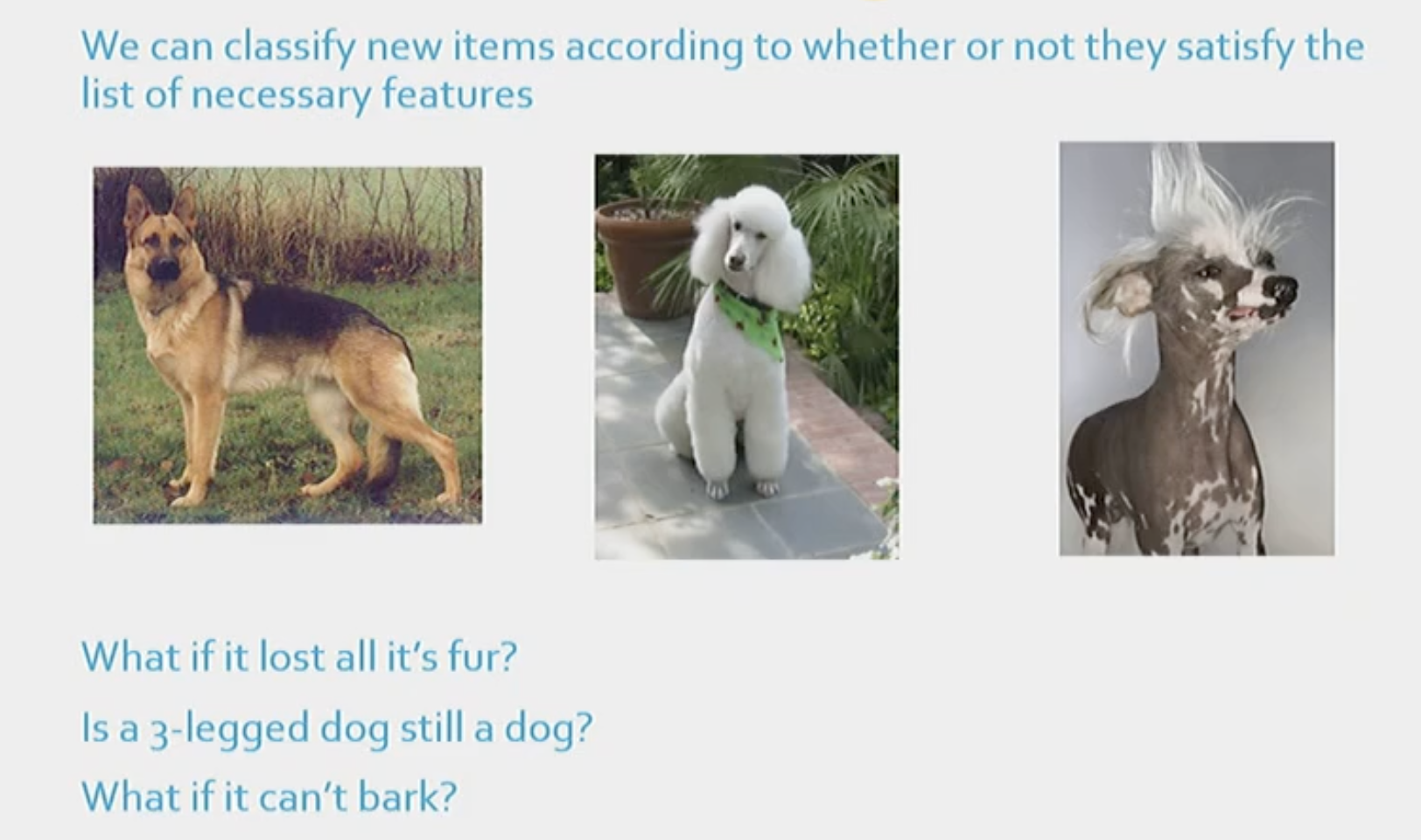
Explain another issue with the classical view when it comes to forming categories.
The classical view explains that an item is in or out of a category, and that there is no in-between. However, this is not true.
For example, say you are shown the list in the image an asked to rank its ‘birdiness’. The numbers on the left are typical means for how birdy people felt each item was. We should have given a 1 to every item, except the bat who would get a 7. However, items that were not birds were still ranked for some level of birdiness (ie. bats) because they have bird like features (ie. wings and the size of a typical bird).
Hence, illustrating that there is a grey area when it comes to putting things into categories because there are ways people rationalise their decisions to fit certain ways of thinking. This can lead to typicality effects.
Define typicality effects.
The idea that:
we respond to typical exemplars faster than atypical ones (ie. we would put eagle in the bird category faster than ostrich in the bird category)
we generate typical exemplars more frequently than atypical ones (ie. we would name typical examples of a category faster than atypical ones)
typical items are more affected by priming (ie. if robin is presented and then ostrich, the person would be slower to respond to ostrich as a bird, compared to if chicken was presented before ostrich. This is because chicken is a typical example of a bird which primes us, making us respond faster to ostrich afterwards)
Given the limitations of the classic view, what is an alternative explanation for how we form categories?
Prototype Theory.
Explain Prototype Theory.
The idea that we are not looking for a full list of defining features in exemplars, but characteristic features—features that are likely in a category.
Hence, exemplars do not necessarily need the those features, but they likely will (ie. most birds have wings, but if they do not have wings, they can still be in the bird category).
Therefore, we determine category membership by comparing an item with a prototype stored in our memory.
Within Prototype Theory, what makes it more likely that an exemplar will be part of a specific category?
The more characteristic features the exemplar shares with the prototype, the more likely that exemplar will be part of the category.
What is a prototype?
The average of all the category members you’ve seen.
Within the prototype theory, what do all category members need?
All the category members need to share a family resemblance (at least 1 feature is shared with one other category member) even if they are not typical members.

Explain Exemplar Theory.
It is an alternative theory that addresses typicality effects. It says that we do not store a prototype and then match specific exemplars to it, instead we store a copy of every single exemplar.
Hence, when we see a new item, we match it to an exemplar stored in our memory. If we find a match, we put that exemplar into that category. However, if we do not find a match, then it is not part of a category, unless someone tells us it is—then we add it in as a member and now we have a stored prototype of that exemplar.
Is categorisation learned?
Yes.
Explain the differences in the direction of prototype and exemplar theory?
In exemplar theory, we store a list of every item within the category and if we have to average them into a prototype we can.
Whereas, prototype theory says that we store a prototype of an item and if we need to pull up a list of specific exemplars, you can do it too.

What does current research suggest is the best theory?
Exemplar theory.
What is an issues about prototype and exemplar theory?
The problem is that the categories made from these theories are based on similarities.
The problem with that is that perhaps typicality effects are not real. If typicality effects are not real, then the prototype and exemplar theory are not needed because they are accounting for something that is not real. Therefore, maybe the classical view is right.
For example, “how are a TV or banana similar?” There are many ways for them to be similar, but none of those similarities matter when trying to put them into a category. Therefore, how do we know which features of items are important for categorisation, and which one’s are not?
This highlights a limitation as it seems as though there is no concrete way to know what is and is not important for categorisation. Hence, perhaps these typicality ratings are a consequence of the experimental set-up that people just play along with, but it does not mean that categories are actually like that.
Why were explanation-based theories made?
They were made in order to address the limitations of the prototype and exemplar theories.
Explain explanation-based theories.
They proposed that we just know what features are considered important and which one’s are not considered important because of our knowledge, beliefs and implicit ideas.
How do children learn about the categories of things?
Children are taught about categories as they experience the world and they are explicitly taught different categories. Through this interaction with the world and explicit lessons, children develop implicit ideas about category membership—you just know.
What causes category membership according to explanation based theories?
Psychological essentialism.
Define psychological essentialism.
All the implicit ideas that tell us something belongs in a natural category.
(ie. how do we know a dog belongs in a dog category, because it is ‘doggy’)
Explain a study about psychological essentialism.
Let’s say you tell children a story about a cat that really wants to be a skunk. The cat makes all of these changes to make itself look like a skunk (black and white stripes, stinky pads).
Then children are told another story about a toaster that really wants to be a coffee maker. Someone disassembles the toaster and reassembles the parts to make a coffee maker.
When children were asked what each end-product was, the children were willing to accept that the toaster became a coffee maker. However, they were not willing to accept that the cat became a skunk. The children said, that they thought this because the cat has a cat mommy and daddy, and a skunk has a skunk mommy and daddy—so the thing is a cat.
This is what psychological essentialism is.
Do we use psychological essentialism to explain category membership for natural categories? How do we use it?
Yes.
We use it by categorising humans (a natural category) which plays into how stereotypes are made. This is because, people think that because certain people have some features, they can never change and that they will be part of that category forever. However, this is not true as most of the categories we have built in our societies are social constructs.
What are the 3 levels of categorisation?
Basic Level
the level that seems ‘just right,’ not too broad and not too specific
hence, the categories are informative and distinctive
one category is different enough from the other that we can tell them apart (ie. dog or piano)
Superordinate
one level above the basic level
more distinctive than a basic category, but less informative
therefore, if you know something is a mammal, you know some info about it but not enough to know it’s a dog (but you know it’s not an instrument)
Subordinate
one level below the basic level
more informative, but less distinctive than the basic level
for example, a poodle is not as different as a dachshund, compared to a mammal and an instrument—so less distinctive. However, if you know its a poodle you can know a lot of information about it.
How does our knowledge about the category shift the levels of categorisation?
The more we know about a topic, the basic level shifts upwards and starts to encapsulate more complex information, that for others may be in their subordinate level. Hence, the other levels also shift accordingly.
What are semantic network models concerned with?
They are concerned with how different items are related to each other.
How do semantic network model’s work?
All network models have nodes that contain information and are connected to each other via directional pathways.
When there is something present in the environment, the node will activate and spread to other nodes along the pathway (the process of spreading activation). This is how information spreads.
Explain Collins and Quillian’s Hierarchical Model.
Collins and Quillian’s Hierarchical Model is a hierarchy that contains nodes that are connected via pathways. The idea is that when you see something in your environment, the ‘tree node’ becomes active and the activation spreads to the connected nodes via the pathways.
Within this model there are 2 types of pathways:
Property pathways - the features of the item (ie. a tree has bark, leaves, roots)
ISA pathways - talks about category membership (ie. a pine is a…)
Moreover, this model has property inheritance. This is where all the subordinate nodes inherit the properties of the nodes above it. So, a plant inherits the properties of living things and a tree inherits the properties of plants. This means that the properties don’t have to be repeated at every node. This saves resources because you can just move up or down the hierarchy.
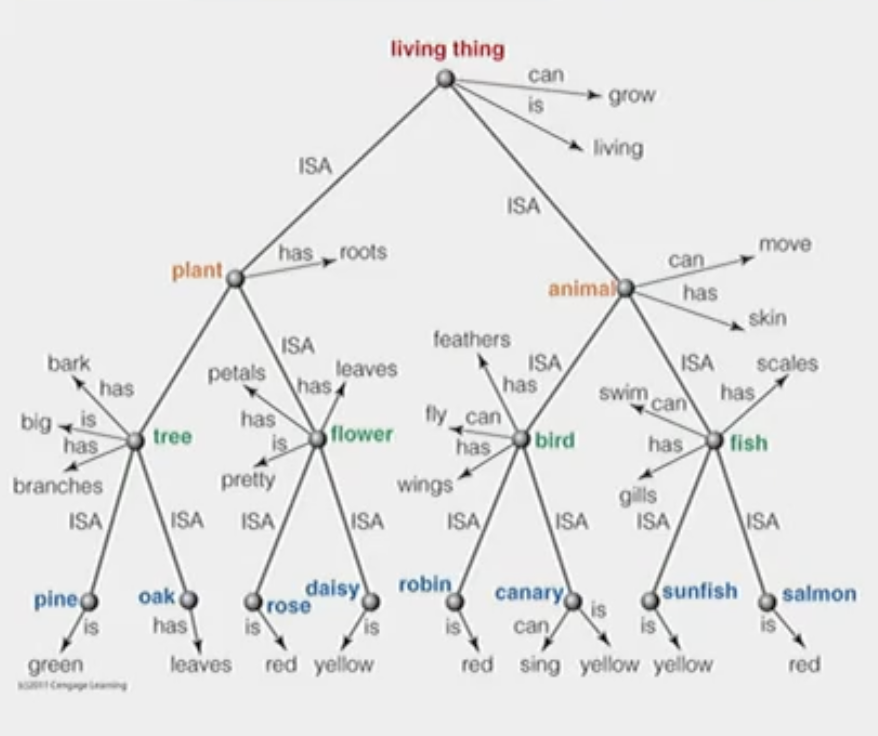
What did Quillian do?
He wanted to create a program that mirrored how humans represent knowledge in their minds.
Define property inheritance.
When moving down the hierarchy, concepts inherit properties from concepts higher in the hierarchy.
What is a limitation to Collins and Quillian’s Hierarchical Model?
Nodes that are farther apart in the hierarchy will take longer to travel between. Therefore, the activation of nodes that are farther apart will take longer.
What did Collins and Quillian’s test when they made the Hierarchical Model for humans?
They tested how quickly people were able to think of information when the nodes were close or far apart from each other.
For example, if someone was thinking about an Oak Tree, they should be able to access other information about trees better than living things (due to the distance between the nodes being smaller).
How did Collins and Quillian test how the distance between the nodes affects people’s ability to retrieve information?
To test this, participants were tested on true or false sentences.
is a canary a canary (fastest)
is a canary a bird (medium)
is a canary an animal (slowest)
The prediction would be that sentence 1 would be recognised the fastest and that sentence 2 and then 3 would follow. This is because it follows the distance in the hierarchy. That is exactly, what they found.
They found similar results when they tested characteristics about canary’s:
a canary can sing (fast)
a canary has wings (medium)
a canary has skin (slow)
Therefore, supporting a hierarchical model.
What is a problem with Collins and Quillian’s study? Explain another test that contradicts Collins and Quillian’s study.
The canary in the study is a typical bird. However, this hierarchical model does not work for atypical items.
For example, participants responded faster to a chicken being an animal vs. a chicken being a bird. However, animal is 2 levels up the hierarchy and bird is only 1 level up. Therefore, if knowledge is really as sorted as a hierarchy, responses should be faster to the knowledge when it is closer to the node.
Hence, suggesting that a hierarchy does not exist.
Explain Collins and Loftus’ Semantic Relatedness Model. How does it differ from the Hierarchical Model?
Like the Hierarchical Model, there are property and ISA pathways connecting nodes and when something in the environment is present, the node becomes active and the activation spreads to connected nodes via the pathways.
However, unlike the Hierarchical Model, the Semantic Relatedness Model, there is no longer a hierarchy, instead information is organised by semantic relatedness—how similar are the nodes. The more semantically related the items are, the shorter the pathway.
Explain an example of the Semantic Relatedness Model in use.
A robin is a typical bird, and so its node it closer to the ‘bird’ node than a chicken, which is not a typical bird.
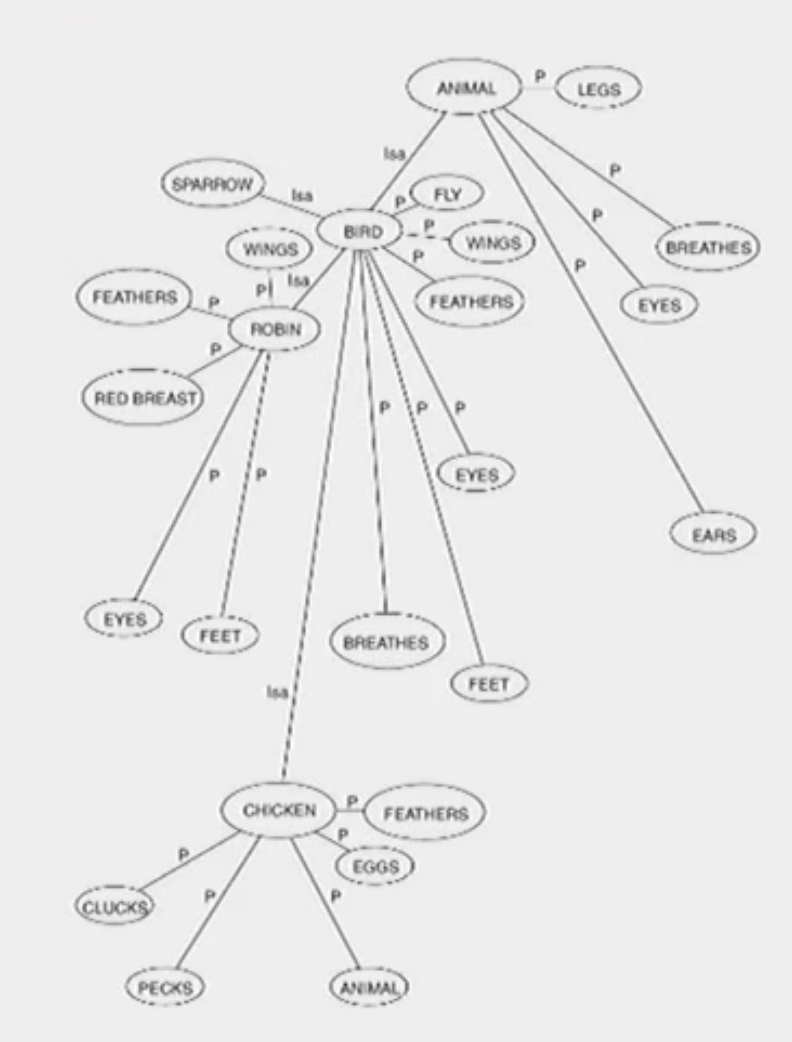
Why did Collins and Loftus’ create the Semantic Relatedness Model?
It helps explain the typicality effects as the nodes are spaced further apart for items that are atypical.
What is a problem with Collins and Loftus’ Semantic Relatedness Model?
Typicality effects are dependent on our personal experiences. For instance, a robin is a typical bird in North America, whereas a Parrot is more typical in Australia.
Due to this, this theory is not a good predictive theory as it depends on what is typical for each person—which can vary quite a lot.
What are Artificial Neural Nets (ANN)?
aka. Connectionists models or PDP
Computing systems that model how neurons in the brain are connected.
What are the similarities between ANNs and Semantic Network Model?
ANNs also have nodes.
What is different about ANNs and Semantic Network Model?
The nodes in ANNs do not have information inside of them. However, the nodes in semantic network models do hold information.
How is information stored in ANNs?
Information is stored as a pattern of activation.
Explain what states the nodes in ANNs can be in and how they are organised.
The nodes in ANNs can be inhibitory, inactive or excitatory like neurons in the human brain.
The nodes are organised into 3 layers: input layer, output layer and hidden layer.
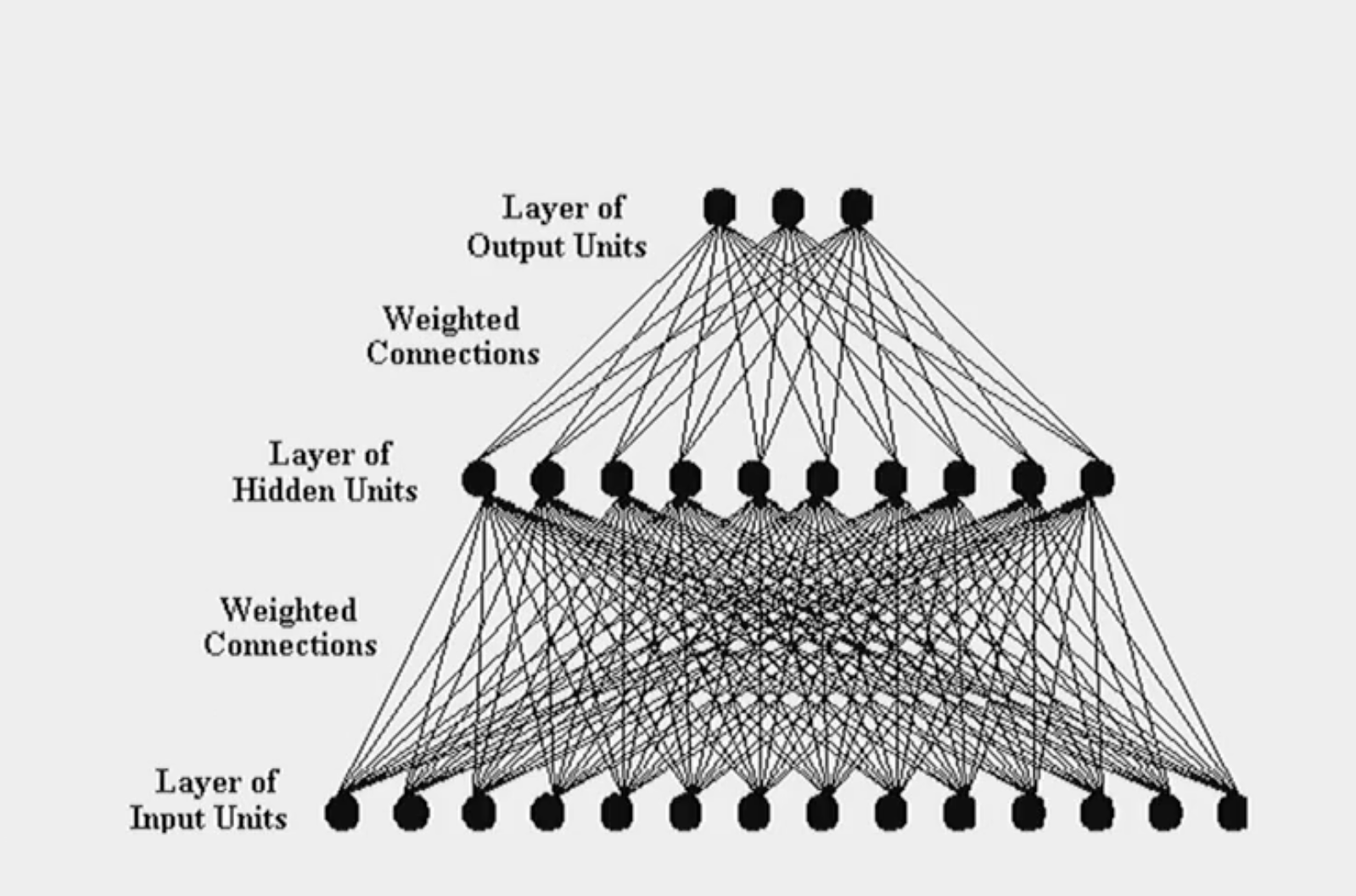
Explain what the input, output and hidden layers in ANNs do.
Input Layer:
Within ANNs, there are 3 layers: the input layer, output layer and hidden layer. The input layer consists of nodes that can be inactive, excitatory or inhibitory. The input layer is equivalent to our sensory receptors that allow us to perceive things in our environment.
Output Layer:
This layer is equivalent to our motor neurons, allowing us to behave according to the input we received
Hidden Layer:
This layer is where cognitive processing occurs
However, this layer is similar to behaviourist ideas about the ‘Black Box’ where we just need to know what goes in and out—and we don’t need to understand the cognitive processes required to go from input to output
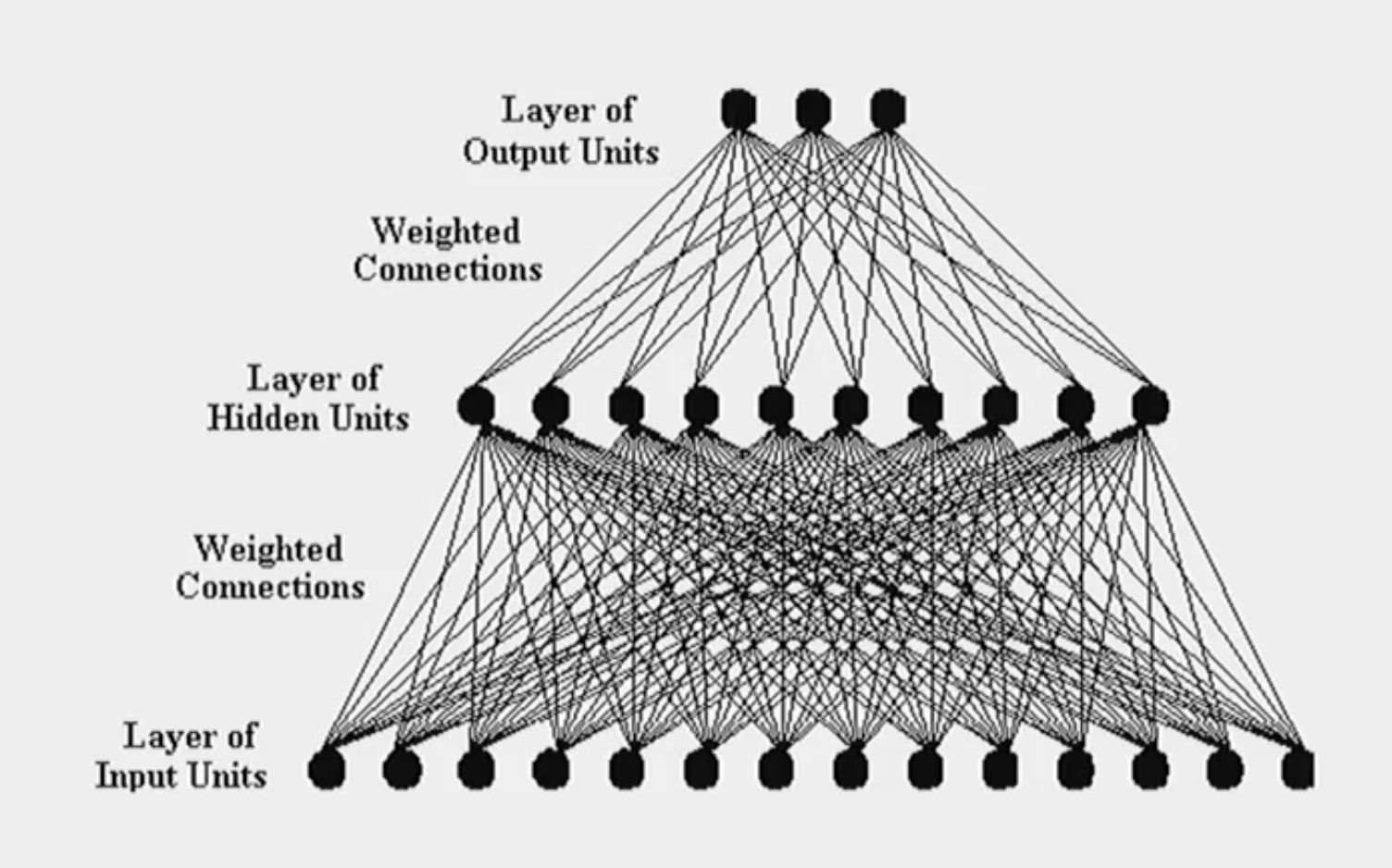
Explain how ANNs are similar to behaviourists ideas.
The hidden layer, as mentioned above, is where cognitive processing occurs. However, like behaviourists thinking regarding the ‘Black Box’, we don’t know what goes in and out—hence, the hidden layer.
We can only observe the input and the output, but we cannot observe the processing that is occurring in the hidden layers.
How are the layers in ANNs connected?
The layers in ANNs are connected via weighted connections. These weighted connections are not just direct pathways, but they adjust how much information that they receive from a node will go to the next node, they adjust the strength of the information passed down.
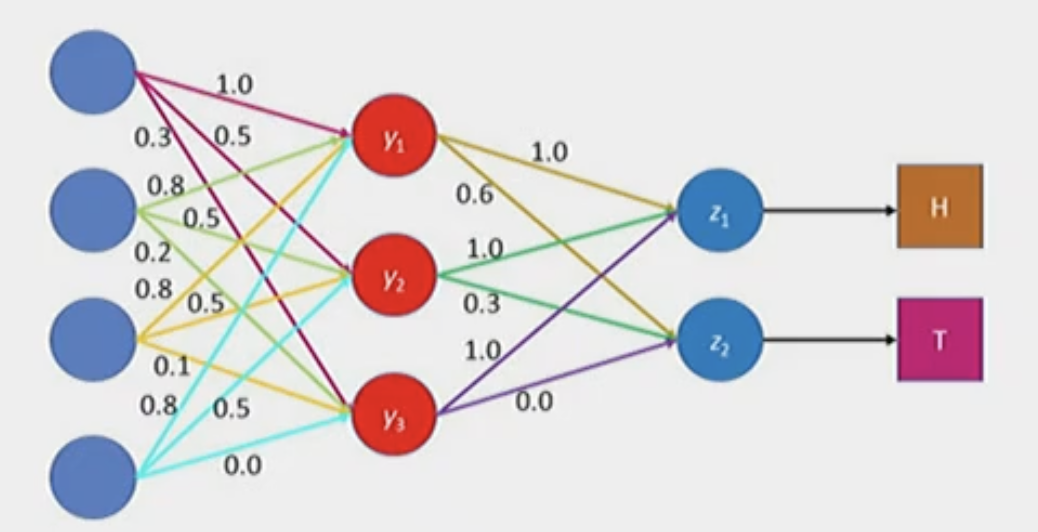
How do weighted connections work in ANNs? What are the implications?
For example, if that node is excited, 100% of the excitation will pass down from the blue node to y1 because the weighted connection is 1.0. However, if that same node is excited, only 50% of the excitation will pass down from the blue node to y2 because the weighted connection has a weight of 0.5.
Also, y1 and y2 (and all the other receiving nodes), will add up the activity they received from the blue node and that will determine their activity level which can be passed down to other nodes through weighted connections.
Therefore, at any time in the input or output layer, a bunch of nodes will have different levels of activity because they are very interconnected and all receive different amounts of information from the previous nodes.
Can the connection weights change in ANNs?
Yes, over time the connection weights can change strengths.
Explain how ANNs learn.
Back Propagation Process
Say you are trying to train a model to distinguish a cat from a dog:
There is something in the environment (ie. picture of dog) that will cause random activity at the input level
The information will spread through the hidden layers
Random output will be formed
At this point, the person who training the model will determine if the output is correct (say it is wrong)
Now back propagation occurs where the information spreads backwards through the model
As the information goes backwards in the model the connection weights are adjusted so that next time the same input is given, the pattern of information in the hidden layer will be a bit different because all the connection weights have changed, thus causing the output to be a bit different
If the output is still wrong, then back propagation will occur again until the output is consistently correct
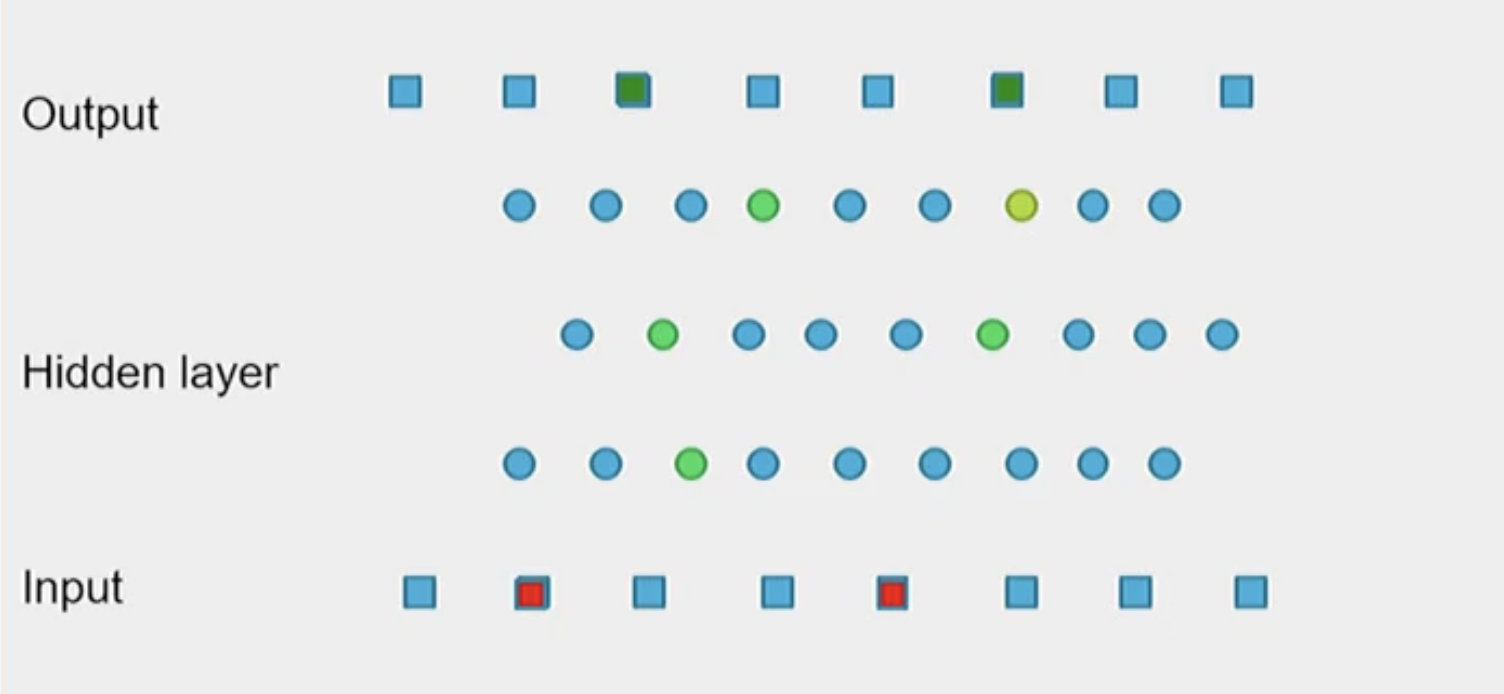
Is pattern fixed for all types of knowledge?
Yes, as long as everything is the same in the input.
What are the features of classic representationalists theories? Explain the features.
Symbolic
we think of items from our environment via in mental symbols in our head that represent items in our environment
Amodal
Knowledge is amodal, meaning it does not depend on our senses
ie. we know what a dog is via semantic connections, list of features etc… It does not matter whether we saw or heard the dog, we still access the same dog knowledge
Decontextualised
our knowledge does not change as the context changes
ie. if a dog is in our room, we still have the same access to our knowledge of dogs compared to if we saw a dog in the park
Stable
our knowledge is stable and unless someone tells us we are wrong, our knowledge stays the same
What are the features of embodied theories? Explain the features.
Simulations
We use simulations to represent our knowledge rather than symbols—so we act as if we are perceiving the real thing
A type of simulation is a neural simulation where if you are thinking about a dog, the neurons that are active when you experience a real dog are the same one’s that are active when you think of a dog (ie. auditory neurons when you hear a dog are active when you think about hearing a dog—you act as if you are perceiving)
Modality-Specific
Given we simulate our knowledge based on our real experiences, our knowledge is dependent on our senses
ie. in order to know what a dog sounds like, we need to have heard a dog before
Situated
Our knowledge depends on the context (we don’t lose knowledge in different contexts, but it is easier to access knowledge in certain contexts compared to others)
ie. the access of information we have about apples is different when we are in a bakery vs. apple orchard. The knowledge of apples is still there, but the access of apple information you have is different depending on your environment
Dynamic
Our knowledge is dynamic, meaning the knowledge we have changes as the situation we are in changes
Explain a study about embodied cognition. What were the findings?
Participants were shown one the two sentences:
The chef saw the egg in the refrigerator
The chef saw the egg in the pan
Then participants were shown a picture of a fried egg or a whole egg. The participants were then asked if the item in the picture was in the sentence they read and their response times were measured.
Participants said yes for both images. However, participants who were shown the first sentence reacted slower to saying yes when they saw the fried egg vs. the whole egg. Similarly, participants who read the second sentence reacted slower to saying yes when they saw the whole egg vs. the fried egg.
How do the findings from the embodied cognition study support an embodied cognition view?
According to a classical view of knowledge, whether participants were shown a fried egg or whole egg is irrelevant to how people should respond as an egg was mentioned in both sentences and the images were both of eggs.
However, according to a embodied cognition view of knowledge, the image participants are shown, the image does matter. This is because, if an egg is in a fridge it is usually a whole egg. However, if it’s in a pan its usually cracked. Therefore, the image that people are shown should affect the access of knowledge they have.
The results support the embodied cognition view of knowledge as participants’ response times were slower when the configuration of the egg did not match the sentence, and vice versa.
Hence, indicating that people can access information faster when the knowledge matches the situation they are in.

Do you know the learning objectives?